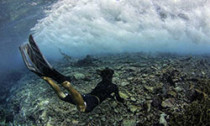Not only that, but they can do it better and more economically than even the best human engineers. The median cost for building an artificial breakwater is $19,791 per meter, the study’s authors report, while the median cost for coral-reef restoration projects is about $1,290 per meter.
In other words, preserving coral reefs is 15 times cheaper than trying to mimic them with concrete.
“Coral reefs are wonderful natural features that, when healthy, can provide comparable wave reduction benefits to many artificial coastal defenses and adapt to sea-level rise,” says Curt Storlazzi, an oceanographer with the U.S. Geological Survey and co-author of the new study. “This research shows that coral reef restoration can be a cost-effective way to decrease the hazards coastal communities face due to the combination of storms and sea-level rise.”
The lagoon coral reef and shore at Ant Atoll, Pohnpei, Federated States of Micronesia. (Photo: © Nick Hall/The Nature Conservancy)
The researchers analyzed 250 previous studies on coral reefs to quantify their wave-breaking abilities. On average, only 3 percent of a wave’s energy made it past a reef, with most of that energy erupting where the reef crest meets the open ocean. The exact amount of energy disruption depends on a few variables, though, including the depth of a reef and the roughness of its texture.
Shallow and jagged reefs are the most effective barriers, the study shows, making them invaluable natural resources as man-made climate change swells sea levels by up to 3 feet and boosts the number of category 4 and 5 hurricanes over the next century. These reefs can only save us from ourselves if we let them, though. Corals around the world are
endangered by a variety of human activities, including water pollution, invasive species and, ironically, climate change. Warm, acidic waters in the Caribbean have been especially hard on jagged species like staghorn and elkhorn coral, for example, both of which are
now candidates to join the U.S. endangered species list.
But while ocean acidification and rising water temperatures can be deadly to corals, there’s also
some evidence these animals can endure such sudden changes — with a little human assistance.
“While there are many concerns about the future of coral reefs in the face of climate change, there are still many reasons for optimism about the future of coral reefs, particularly if we manage other local stressors such as pollution and development,” says Fiorenza Micheli, a biology professor with Stanford University’s Hopkins Marine Station and a co-author of the new study.
Brandon Bourke of the Nature Conservancy dives under a breaking wave at a reef crest in Palmyra Atoll. (Photo: © Tim Calver/TNC)
Conservation efforts often focus on remote coral reefs, but the study’s authors suggest reefs near people should be at least as high a priority. Not only are those reefs often at greatest risk from pollution, development and overfishing, but they also have the most potential to directly protect civilization. About 197 million people worldwide live less than 10 meters above sea level and within 50 kilometers of a coral reef, and they’ll face much higher costs from natural disasters if those reefs die.
“This study illustrates that the restoration and conservation of coral reefs is an important and cost-effective solution to reduce risks from coastal hazards and climate change,” says Filippo Ferrario, a biologist at the University of Bologna and lead author of the new study.
Here’s a list of the 15 most coral-protected countries on Earth, ranked in terms of the number of people who receive risk-reduction benefits from coral reefs:
1. Indonesia: 41 million
2. India: 36 million
3. Philippines: 23 million
4. China: 16 million
5. Vietnam: 9 million
6. Brazil: 8 million
7. United States: 7 million
8. Malaysia: 5 million
9. Sri Lanka: 4 million
10. Taiwan: 3 million
11. Singapore: 3 million
12. Cuba: 3 million
13. Hong Kong: 2 million
14. Tanzania: 2 million
15. Saudi Arabia: 2 million
A wave breaks over a healthy coral reef in Tumon Bay Marine Preserve, Guam. (Photo: Curt Storlazzi/USGS)
Corals grow near a mangrove swamp in the coastal waters at Kofiau, Indonesia. (Photo: © Jeff Jonover/TNC)













Social Profiles